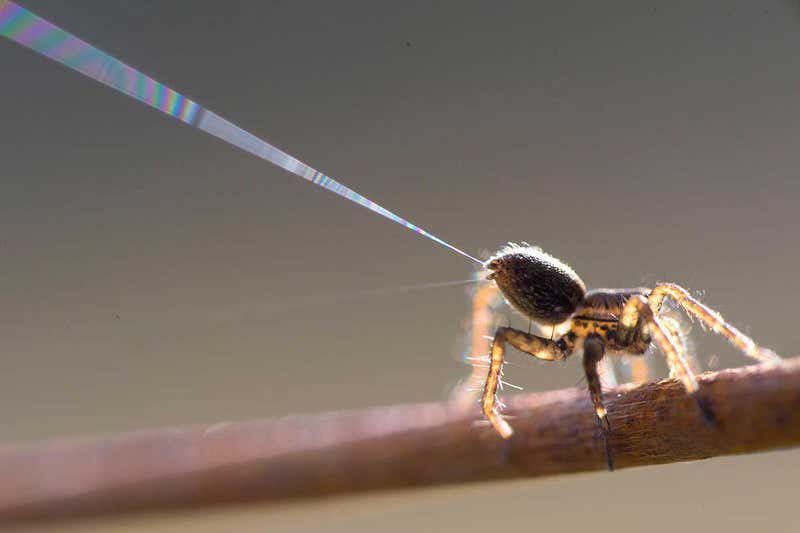10 Common California Spiders That Might Be Nesting in Your Home
When you’re in the middle of a peaceful slumber, and something crawls across your face, it can be enough to startle even the soundest sleepers. But how can you tell what type of creature has infiltrated your bedroom for a midnight visit?
Most likely, it’s one of the many spiders inhabiting US homes. Though over 91,000 species of bugs live in America alone, spiders found in the US are mainly nocturnal and often make surprise appearances during the night. And while they may look scary with their eight legs and bulbous eyes, spiders help keep our homes safe by feeding on other bugs like mosquitoes and flies.
California is home to around 610 unique bug species, but many live far from humans. California’s 66 spider species tend to live closer to humans, though, and that’s probably what woke you up in the middle of the night.
Look for clues such as web patterns or coloration to help identify which spider may have joined you in bed.
Spiders in California are both a pest and a natural pest control service. The 8-legged hunters you find in your home aren’t out to hurt you. But accidents still happen when venomous spiders feel threatened by your presence.
Keep your family safe and learn to ID the spiders around your home. If anything happens, you know what to tell the doctors and pest control team.
Here are 10 common spiders you’ll find in California.
1. Banded Garden Spider
The Banded Garden Spider is found throughout California and is one of the most common types of spiders residents find in their homes. Also known as Argiope trifasciata, it is a species of orbweaver found in gardens and fields. This spider, which has a body usually ranging from 1/4 to 1 inch long, carries a vibrant yellow hue with black stripes along its abdomen and legs. The legs of the Banded Garden Spider are noticeably longer than its body.
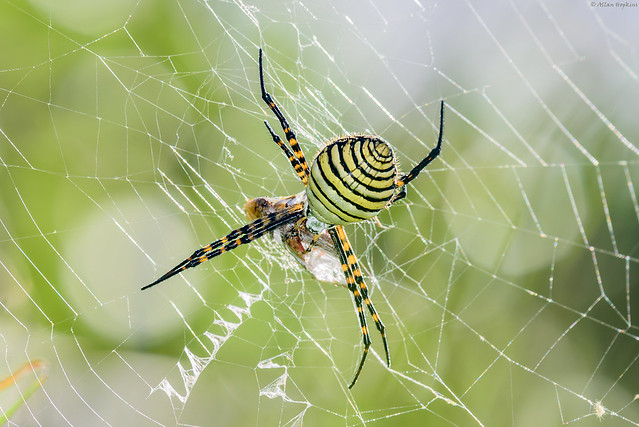
The webs of Banded Garden Spiders are typically orb-shaped, with a circular design and radiating spokes. Webs built in open, sunny areas such as gardens, fields, and meadows can reach up to 2 feet in diameter and are strong and sticky, designed to catch flying insects.
Mainly feeding on flying insects caught in their web, but when necessary, the branded garden spider will hunt and feed on other small arthropods, such as spiders and mites. Overall, their diet is diverse and depends on prey availability in their environment.
Banded Garden Spiders are typically outdoor creatures and do not usually live inside homes. However, they may occasionally enter homes to capture prey or to find a place to lay their eggs. Females that have laid eggs will bite in self-defense when they feel threatened.
The Banded Garden Spider is venomous but is not considered poisonous to humans. Their bite is not toxic and typically does not cause any significant health problems. In
2. Johnson’s Jumping Spider
Johnson’s Jumping Spider, also known as the Phidippus johnsoni, is a species of spider in the family Salticidae, commonly known as jumping spiders. Sometimes mistaken for the red-backed jumping spider Johnson’s Jumping Spiders have a distinctive appearance, with a glossy black body and bright, iridescent green or blue markings on their legs and abdomen. They are relatively small, with a body length of about 5-8 mm and a leg span of up to 20 mm.
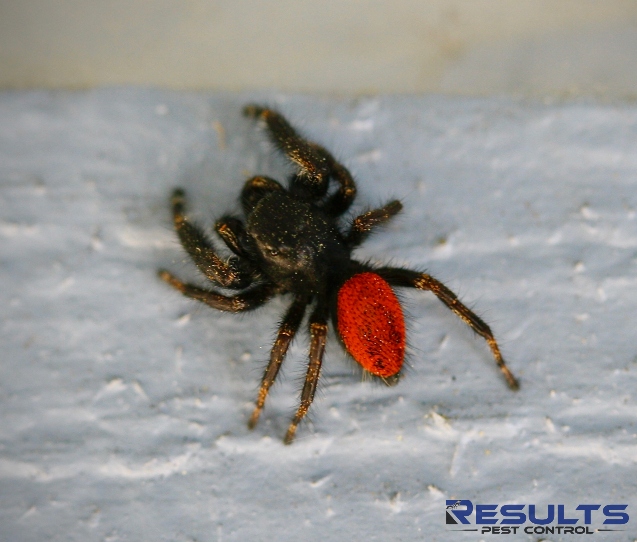
Found in urban and suburban areas, including homes and gardens, jumping spiders are attracted to homes for the availability of food and shelter. They can enter homes through open doors, windows, cracks, and crevices in the walls and foundations. Once inside, Johnson’s Jumping Spiders can be found on walls, ceilings, and in the corners of rooms.
Johnson’s Jumping Spiders, a common house spider, do not make webs. They are predators and hunt for their food rather than relying on webs to catch it. Jumping spiders have keen eyesight and can precisely track their prey. They can jump several times their body length to catch insects, other spiders, and other small creatures.
Johnson’s Jumping Spiders are not dangerous to humans and are generally considered beneficial because they feed on other insects, including some that are considered pests. They are often kept as pets by hobbyists who appreciate their bright colors and playful behavior.
3. Grass Spider
Grass spiders, also known as the Agelenopsis sp., are members of the funnel web spider family. Grass spiders have a distinct, tan to dark brown appearance, with a rounded abdomen and long, spindly legs. Their size varies between species, with some individuals reaching up to 1 inch in length.
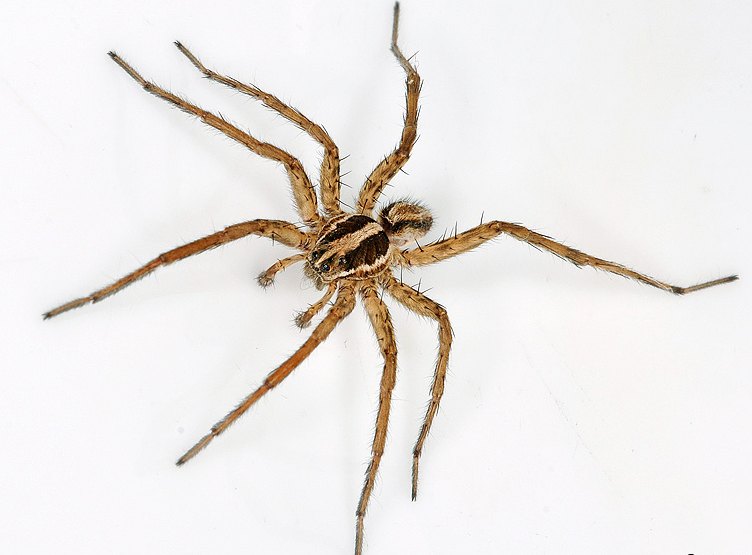
Grass spiders are opportunistic hunters that feed on insects, including flies, moths, and beetles. They are most active at night and spend the day hiding at the entrance of their web or a nearby hiding place.
Grass spiders are ambush predators that do not actively hunt their prey but instead wait for insects to become trapped in their webs. The spiders build funnel-shaped webs with a smooth entrances and a tangled, sticky center. When insects fly into the web, they become stuck in the sticky center and cannot escape.
Grass spiders use their long front legs to sense vibrations in the web, and when they detect prey, they quickly grab it with their fangs. They then inject venom into the prey to immobilize it before wrapping it in silk and eating it.
Grass spiders are not typically found indoors but may enter homes and buildings through open windows or doors. If a grass spider does enter a home, it is likely to build its web in a quiet, undisturbed area where it can trap prey.
Grass spiders are venomous. Venom is used to immobilize its prey and is not considered harmful to humans. In rare cases, a bite from a grass spider may cause mild pain and swelling, but these symptoms usually resolve within a few hours. The venom of grass spiders is not considered medically significant, and bites from these spiders are generally not dangerous to humans. However, if you experience any symptoms after a bite from a spider, it is essential to seek medical attention.
4. Cellar Spider
Cellar spiders belong to the family Pholcidae and are true spiders with two main body parts, eight legs, and the ability to make webs. Cellar spiders have small, flat bodies ranging from 0.25 to 0.5 inches in length. They are typically light brown to gray, and their bodies are covered in fine hairs.
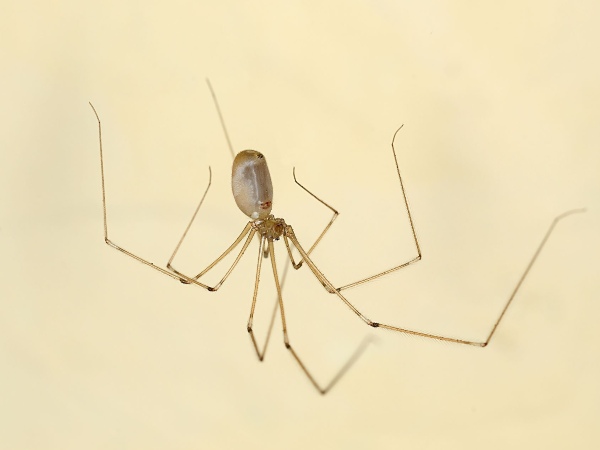
Cellar spiders are often found in dark, damp places, such as cellars, basements, crawl spaces, and other similar environments with little light and high humidity. These conditions provide the ideal habitat for these spiders to hunt and capture prey.
Cellar spiders are known for creating messy webs that can become unsightly and make some people have a fear of spiders. These webs often have a disorganized, tangled appearance and can accumulate debris over time.
The Cellar Spider will hang upside down in their web until prey comes along, then they quickly ambush the victim.
Cellar spiders have a pair of fangs that they use to bite and hold onto their prey. They then inject a potent venom that immobilizes their target, allowing them to feed at their leisure.
After they have finished feeding, they will often wrap the remains of their prey in silk to prevent it from escaping or attracting other predators.
Cellar spiders are often found in homes. They can easily find their way indoors through small cracks and crevices. Once in the house, cellar spiders are typically found in areas like basements, crawl spaces, closets, attics, and other similar environments.
While cellar spiders have venom, their bites are not considered harmful to humans and are generally not a cause for concern.
Cellar spiders are commonly referred to as “daddy long legs,” they are not the same species and belong to different groups of animals.
5. Yellow Sac Spider
The Yellow Sac Spider (Cheiracanthium punctorium) is commonly found in North America and has several distinctive characteristics. The northern Yellow Sac Spiders are small and have a yellowish-green to pale yellow body and legs. They grow to be about 6-10 millimeters in length. The Yellow Sac Spider has eight eyes that are arranged in two rows of four eyes each. The eyes are small and round and are often described as shiny.
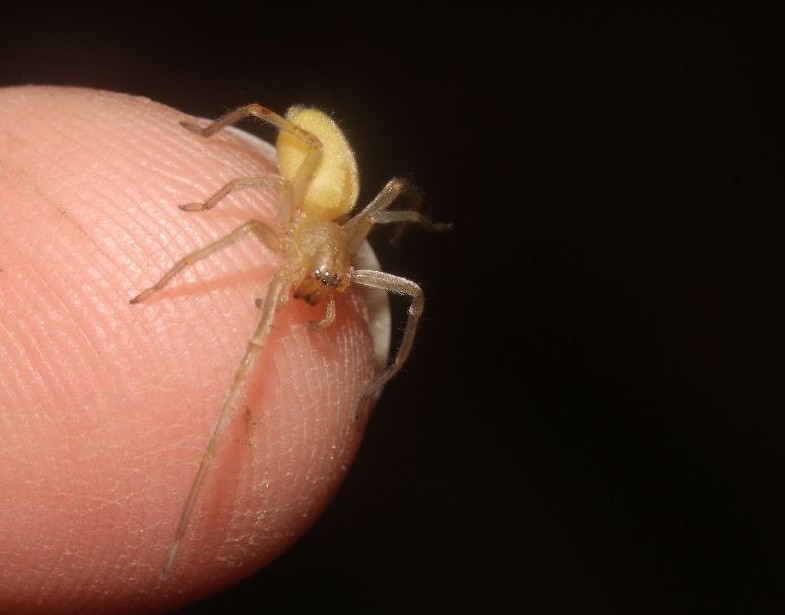
Yellow sac spiders are yellow and tan with equal-sized body segments. It’s easy to mistake one of these spiders for a piece of dust in a pile of clothes. If you know your home has yellow sac
Yellow Sac Spiders are often found in residential gardens, where they hunt for insects among the plants or hide in underbrush or trees.
The Yellow Sac Spider is a hunting spider that actively searches for its prey. Unlike web-building spiders that catch prey in their webs, Yellow Sac Spiders use their sharp fangs and toxic venom to paralyze their prey.
Once it paralyzes, wraps the victim in silk to secure it for later consumption. The Yellow Sac Spider feeds on various small insects, including mites, flies, and beetles.
During the cold months, yellow sac spiders come inside to find the warmest place possible. Look up and see yellow sac spiders hanging out on the ceiling. They love high places indoors because heat from the HVAC system rises.
Yellow Sac Spiders are nocturnal and are known for their aggressive behavior. They are known to bite humans when they feel threatened or trapped. Indeed, this spider is one of the common spiders you may want to be aware of around small children.
The Yellow Sac Spiders venom is toxic to insects, but the venom is considered to be of low toxicity to humans. However, some people may experience mild to moderate symptoms such as pain, redness, and swelling at the bite site.
6. Wolf Spider
Wolf spiders are medium to large-sized, with body lengths ranging from 0.5 to 1.5 inches (1.3 to 3.8 cm). They are usually brown or grayish and have a mottled or streaked appearance, which helps them blend into their natural surroundings. Their bodies are covered in dense hairs, giving them a furry appearance. They have eight eyes arranged in three rows, with the two most prominent eyes located in the center row.
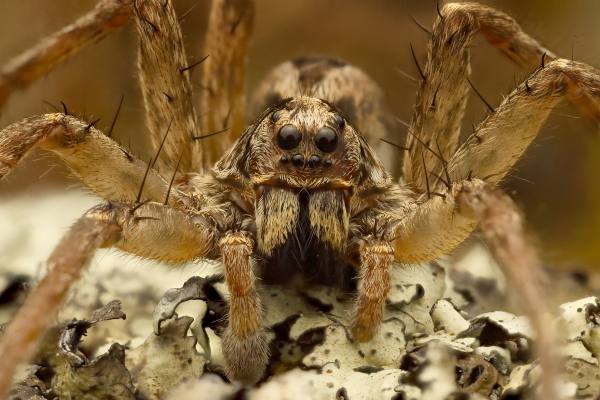
They are one of the most common brown spiders in California. Wolf Spiders can be found hiding in burrows or under rocks and logs. They also live in leaf litter, crevices, and cracks in rocks and soil. In urban areas, they can be found in gardens, yards, and even inside homes, where they will hide in basements, crawl spaces, and other dark and damp places.
Wolf spiders are widespread in areas with plenty of ground cover and vegetation, providing them with plenty of hiding places and opportunities to hunt their prey. They are also commonly found near water sources, as this attracts insects, their primary food source.
Wolf spiders are hunters and do not use webs to capture prey. Instead, they rely on their speed and agility to chase down and catch their food.
When hunting, wolf spiders use their excellent eyesight to locate their prey. Once they have spotted a potential meal, they will give chase and use their sharp, spiny legs to grasp and hold onto their prey. They then use their powerful jaws to bite and inject their venom, immobilizing their victim.
Wolf spiders are opportunistic feeders and eat insects and other small creatures, including ants, beetles, crickets, and other spiders. They are especially attracted to insects that are attracted to light, such as moths and flies, which they will readily pursue and capture.
In general, wolf spiders are solitary creatures who hunt and feed independently rather than relying on webs or other forms of teamwork to catch their prey. However, they sometimes work together in small groups to capture larger prey, such as grasshoppers or crickets.
Wolf spiders typically enter homes through small cracks and crevices in the foundation or walls or through open doors and windows. Once inside, they will hide in dark and moist areas, such as basements, crawl spaces, and closets.
While wolf spiders are not dangerous to humans, some people may be allergic to their venom and experience a reaction if bitten. Bites from a wolf spider swell and itch for a few days. For those allergic to spider bites, the reaction can include painful ulcers. Seek attention for the bite if you see hives or a red line running from the wound. Additionally, their large size and fast movements can be intimidating, especially to those afraid of spiders.
7. California Tarantula
The California tarantula (Aphonopelma californicum) is a large, fuzzy spider native to the southwestern United States, sometimes referred to as the desert tarantula. They typically have a brownish or dark gray coloration and can grow up to 4 to 5 inches in length, including their legs. They have eight legs covered in thick hair, and their body is also covered in hair, which helps to camouflage them in their natural environment. The California tarantula has a distinctive round body and large fangs that are used to capture prey. They are non-aggressive and will only bite as a last resort in self-defense.
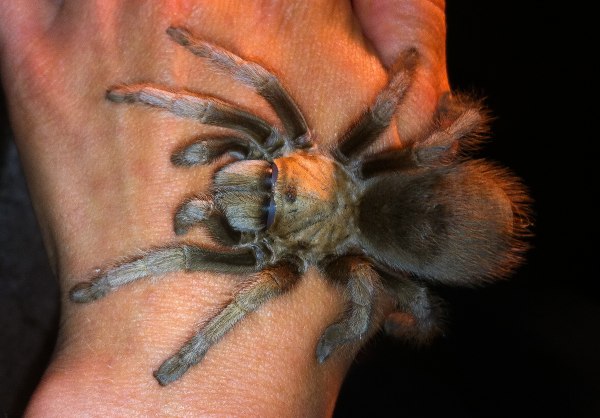
The California tarantula’s natural habitat is the deserts and semi-arid regions of the southwestern United States, including California, Nevada, Arizona, and New Mexico. They prefer to live in loose, sandy soil where they can construct their burrows and retreat from the hot, dry surface. These burrows can be up to 18 inches deep and provide the tarantula with a cool, moist, and safe place to hide.
The California tarantula is a solitary hunter and finds its prey primarily through passive means. They do not actively search for prey but instead wait in or near their burrows for something to come within striking distance. They have excellent senses of touch and vibration and can detect the movement of potential prey through the ground.
While California tarantulas may occasionally be seen wandering near homes or other buildings in their natural habitat, they do not typically take up residence inside. They are not considered pests and do not threaten humans or pets. They are generally non-aggressive and will only bite as a last resort in self-defense. If you encounter a California tarantula in or near your home, it is best to leave it alone and let it continue on its way.
The venom of the California tarantula is much less toxic than that of many other species of spiders and is comparable to a bee sting in terms of its effects. Most people who a California tarantula bites will experience only mild symptoms, such as redness and swelling at the bite site, and may also experience pain and itching. In rare cases, a person may have an allergic reaction to the venom, which can be more severe and require medical attention.
8. Black Widow Spider
The black widow spider (Latrodectus genus) is a member of the Theridiidae family, also known as the tangle-web spiders or comb-footed spiders, and at times mistaken for the false black widow, which is not found in the USA.
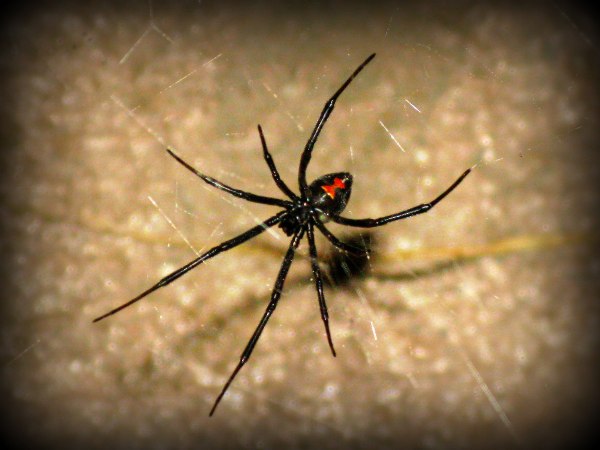
The black widow spider found throughout California is one of the most common California spiders. Recognizable by its glossy black body and bright red hourglass-shaped marking on its belly. A mature female black widow is solid black with a bright red hourglass on the abdomen with a body length of about 1 inch. Male widows are around 1/3 the size and remain golden brown with white patterns. The spiderlings look like the males but have lighter color patterns.
Black Widows are known for their preference for dark, sheltered habitats and are often found in areas where they can spin their webs without disturbance.
They build their webs in areas protected from the elements, such as sheds, garages, firewood piles, lumber, and other outdoor storage areas.
Black Widows commonly build their webs near a water source where insects looking for moister become easy prey.
The black widow spider is an opportunistic predator that feeds on insects and other small invertebrates. Some of the most common prey items for black widow spiders include flies, crickets, beetles, and other small insects caught in the spider’s web.
The black widow spider captures its prey using a web that is composed of both sticky and non-sticky silk. The sticky silk is used to entangle the prey, while the non-sticky silk helps to stabilize the web. When an insect becomes trapped in the web, the black widow spider will quickly wrap it in additional silk to immobilize it. Once the prey is secured, the black widow spider will bite it to inject venom, which paralyzes the insect and makes it easier for the spider to feed.
It’s important to note that black widow spiders are not active hunters and often wait for their prey to come to them. This allows them to conserve energy and focus on feeding and reproducing. By carefully constructing and maintaining their webs, black widow spiders can take advantage of the abundant food resources available in their environment and successfully survive in various habitats.
Clutter in a home can provide a suitable habitat for black widow spiders, as it offers a variety of hiding places and protection from the elements. However, it’s worth noting that black widow spiders do not necessarily seek out cluttered homes specifically. Instead, they are attracted to any dark, sheltered places that offer protection from the elements and potential predators. If a messy house provides such a habitat, black widow spiders may take advantage of it.
It’s also worth noting that while clutter may provide a suitable habitat for black widow spiders, it can also make it more challenging to detect their presence and take steps to remove them. For this reason, it’s a good idea to keep your home free of clutter and to regularly inspect for the presence of black widow spiders and other pests.
Black widow spiders are indeed venomous, and their bite can harm humans. The venom of the black widow spider contains a mixture of toxic compounds, including a potent nerve toxin that can cause a range of symptoms, including pain, muscle cramps, and abdominal pain. In severe cases, a black widow spider bite can also cause muscle weakness, difficulty breathing, and even death, although fatalities are relatively rare.
It’s worth noting that not all black widow spider bites are equally dangerous. The severity of a bite can depend on several factors, including the spider’s size, the bite’s location, and the sensitivity of the person bitten. Children, the elderly, and people with weakened immune systems are particularly vulnerable to the effects of black widow spider venom. They may be more likely to experience severe symptoms following a bite.
While the venom of the black widow spider can be harmful, it is essential to keep in mind that bites are relatively rare and that most people can recover from a black widow spider bite with proper medical treatment. If you suspect that a black widow spider has bitten you, it is crucial to seek medical attention as soon as possible.
A bite from one of the most dangerous spiders in California can lead to:
- Nausea and vomiting
- Sweating
- Headache
- Cramping
- Lesions around the wound
- Tremors
Over 2,500 people a year suffer from black widow bites. Thanks to a working antivenom, there aren’t many widow bite fatalities. Children and people with heart conditions are most at-risk for a severe reaction.
9. Brown Widow Spider
The brown widow spider (Latrodectus geometricus) is a venomous spider species in the United States and other parts of the world.
Since 2000, brown widows have become one of California’s more common brown spiders.
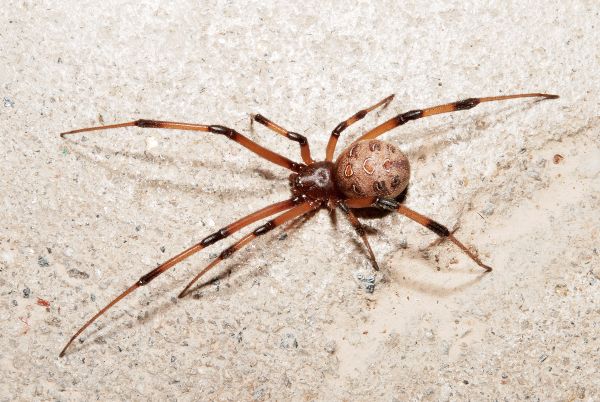
Brown widow spiders have a distinctive appearance, brownish-yellow color, and unique markings on their abdomen. The female brown widow is typically larger than the male, with a body length of about 1.5 centimeters and a leg span of about 4 centimeters. The male is smaller, with a body length of about 0.5 centimeters and a leg span of about 2 centimeters.
Brown widow spiders are often found in human-made structures such as buildings, garages, and sheds. They tend to build their webs in protected locations, such as under eaves, corners of windows, or discarded objects like tires and buckets. They prefer areas close to the ground that provide shelter and protection. They are also commonly found in outdoor furniture, garden equipment, and other items left outdoors and undisturbed for extended periods.
The brown widow spiders capture their food by using their irregular webs to trap insects and other small arthropods.
When an insect or prey item lands on the web, the brown widow spider will quickly move toward it and bite it to immobilize it. They then wrap the prey in silk and feed on it using fangs.
Brown widow spiders feed on insects and other small arthropods, including flies, mosquitoes, beetles, and caterpillars. They also feed on other spiders, which makes them an essential predator in their ecosystem. The brown widow spider’s diet may vary depending on the availability of prey in its habitat.
In many cases, brown widow spiders are introduced into homes as eggs or spiders in objects that are brought inside, such as furniture, firewood, or containers. Once inside, they can establish populations and continue to reproduce, leading to increased numbers of brown widow spiders in and around the home.
Brown widow spiders are venomous, and their bites can cause symptoms such as pain, swelling, muscle cramps, and nausea. It is important to be cautious around these spiders and to seek medical attention if you are bitten.
A bite from the brown widow is nowhere near as dangerous as a black widow. Their smaller size means they can’t inject much venom during a bite. People sensitive to spider bites should seek medical help to be safe.
10. Desert Recluse
Desert Recluse (Loxosceles deserta) is a small, brown spider typically about 1/2 inch in body length. Its body and legs are covered in fine, short hair, and the spider has a characteristic violin-shaped marking on its cephalothorax (the fused head and thorax), which is dark brown or black. The legs are long and slender, and the spider has six eyes arranged in two rows of three.
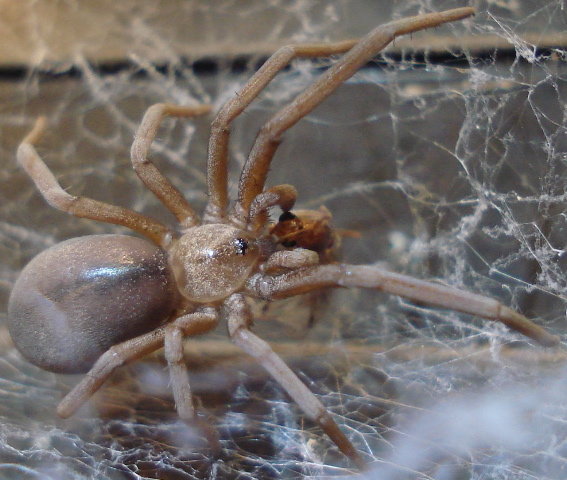
The desert recluse is often mistaken for or misidentified as the infamous brown recluse spider. However, the brown recluse does not live in California.
The Desert Recluse is not typically encountered in California. This spider species is primarily found in the deserts of the southwestern United States, including Arizona, Nevada, and New Mexico. While several species of recluse spiders are found throughout North America, the Desert Recluse is one of the most commonly encountered in its native range.
California is home to two species of recluse spiders, and neither is the brown recluse. The most common Californian recluse is the desert recluse. An invasive species, the Chilean recluse, lives in a handful of places in Southern California.
The Desert Recluse spider feeds on a variety of small insects and other invertebrates, including cockroaches, crickets, and beetles. Like most spider species, the Desert Recluse uses silk to capture prey. It spins a loose, messy web that is used primarily to help it locate prey and detect vibrations rather than physically entangle its food. When a suitable prey item comes into contact with the spider’s web, the Desert Recluse will quickly move in to bite and subdue it with its venom. The spider will then wrap the prey in silk to immobilize it and feed on it later.
The venom of the Desert Recluse spider can be toxic to humans and cause severe reactions, including pain, swelling, redness, and blistering at the bite site.
In some cases, bites from Desert Recluse spiders can lead to more severe complications, such as necrosis (tissue death), infections, and systemic reactions, including fever, chills, and muscle aches. However, it is essential to note that bites from Desert Recluse spiders are relatively rare, and the spider is not considered aggressive. Bites may occur when the spider is unintendedly pressed against the skin, such as when someone puts on a shirt or reaches into a hidden space.
If you suspect a Desert Recluse spider has bitten you, it is essential to seek medical attention as soon as possible. Your doctor will be able to assess the severity of your reaction and provide appropriate treatment, which may include antibiotics, pain relievers, and other medications, as well as close monitoring for signs of complications. With prompt and proper treatment, most Desert Recluse spider bites are not life-threatening, but it is always best to avoid caution and seek medical attention if you have any concerns.
Do You Need Help Evicting Unwanted Spiders in California Homes and Businesses?
Most spiders in California help keep the massive bug population in check. The problem is their webs tend to make a mess and they invade your space. Spider infestations also invite the more dangerous spiders in California inside.
Protect your family from accidental spider bites and bring in a pest control service. Put your spider ID skills to work and tell them what species you’ve seen at home. From there, they will customize an eco-friendly pest control plan.
Results Pest Control is ready to help banish spiders from your home for good. Contact us to request an inspection and get a free price quote.
